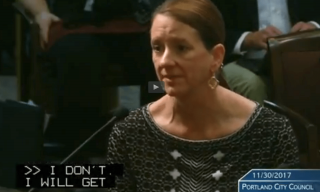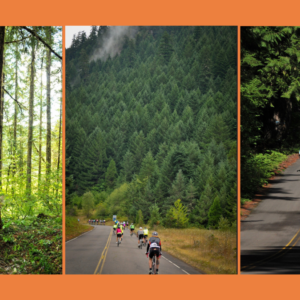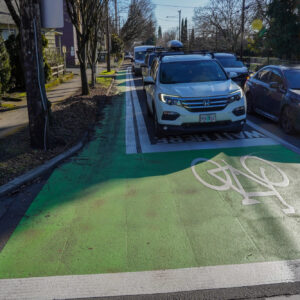
(Courtesy, Jim Howell, AORTA)
A proposed freeway widening project will tear out one of Portland’s most used bike routes,
This story is by Portland writer and economist Joe Cortright. It first appeared on City Observatory.
We’re putting the I-5 Rose Quarter project under a microscope, in part because we think it reveals some deep-seated biases in the way transportation planning takes place, not just in Portland, but in many cities. Today we turn our attention to plans to tear out a key local street which serves as a major bikeway in north Portland.
A quick refresher: I-5 is the main north-south route through Portland, and the Oregon Department of Transportation is proposing to spend at least $450 million to widen it with new lanes on a one-mile stretch just north of downtown. A growing coalition of community groups has organized to fight the project as wasteful, ineffective and at odds with the region’s climate change and Vision Zero goals.
If this project goes forward, Flint Street will dead-end at the new, wider freeway. Rather than “connecting” the community better, the project actually disconnects it.
One of the supposed rationales for the project is that it will “knit together” the fabric of community that was rent asunder by the original construction of the Interstate 5 freeway in the 1960s. (The freeway runs adjacent to areas that then had the largest concentration of African Americans in Portland). The freeway includes several over-sized multi-street overpasses that the project grandly describes as “covers” over the freeway.
While the project touts the so-called covers, it downplays the fact that one element of the project is eliminating the current over-crossing that carries N. Flint Street over I-5. Flint street is a two-lane, two-way neighborhood street that runs parallel to the busier N. Williams/N. Vancouver couplet that funnels traffic on and off I-5. The plan for widening the freeway calls for tearing down the Flint street overpass–and not replacing it.
Disconnecting the street grid
City officials have repeatedly claimed that a key purpose of the project is to knit together a community split apart by freeway construction, in part by improving bike and pedestrian links. Portland Bureau of Transportation Manager Art Pearce told The Oregonian:
“We see the Rose Quarter project as really reconnecting the central city,” said Art Pearce, the Transportation Bureau’s manager for projects and planning. “It has the potential to reconnect the area, make it more of a destination … and having more of the bike and pedestrian streets people have come to expect in other parts of Portland.”
But this project does nothing of the kind, and if anything, severs an important local street. This point was made strongly by long-time local transportation advocate Jim Howell of the Association of Oregon Rail and Transit Advocates (AORTA), in his testimony to the City Council on November 30, 2017. Howell noted that “Flint Street is not going to be replaced, it will be lost to the neighborhood. This is one of the major north-south routes through the neighborhood, it’s been there since it was platted as the City of Albina.” (Howell’s illustration, produced above, shows the overpasses to be replaced by covers or lids (white rectangles) and on the right, the current Flint Street overpass (marked with red x’s) which will be eliminated.)
Advertisement
And this corridor is one of Portland’s busiest, and fastest growing bike routes (it was the subject of a BP photo essay in 2011). In total, about 10,000 bikes per day travel north and south through this project area — a five-fold increase from 2001 levels, according to city bike counts. North Flint street, with its two-way traffic, lower volumes and slower speeds, is an attractive route for many of these cyclists. While the city doesn’t have street level counts, it appears that a majority of southbound riders use N. Flint Street to cross the freeway and reach the Broadway Bridge across the Willamette River: City of Portland bike counts show that 56 percent of southbound morning peak hour trips on N. Williams Avenue turn on N. Russell (a takes them to N. Flint Street). In addition, N. Flint Street is home to the Harriet Tubman middle school, which though currently vacant, is scheduled to be re-opened to serve students from North and Northeast Portland.
The project is proposing a steeply graded new extension of N. Hancock Street that would run east to west as a partial substitute for Flint Street.
If this project goes forward, Flint Street will dead-end at the new, wider freeway. Rather than “connecting” the community better, the project actually disconnects it. It’s coming to be recognized that a grid of local streets better manages traffic flow and enables pedestrian safety. And this project is a step backwards, concentrating more vehicle movements as well as more bicycles on main arterial streets, and eliminating a slower-speed, local serving street.
Why amputate Flint Street?
Given Portland’s reputation (mostly well-deserved) for progressive policy on transportation, you might think that the city would have a clear rationale for killing Flint Street. But according to the discussion at the November 30th Portland City Council meeting, the Director of the city’s transportation bureau didn’t know what it was. After Howell and other presenters questioned the claim that the project would “re-connect the neighborhood,” City Commissioner Amanda Fritz asked Portland Bureau of Transportation Director Leah Treat why the city had eliminated Flint Street. Treat didn’t know.

Here are two exchanges from the Council meeting:
Commissioner Fritz: “I was wondering about the taking out the Flint; What’s the rationale was behind that?”
PBOT Director Treat: “I can’t answer that; I’ll have to get back to you on that.”
…Fritz: “My question was, do you know what the rationale was for taking out Flint?”
Treat: “I don’t; I’ll will get back to you and follow up on that.”
To put this in context: the I-5 Rose Quarter project is the largest transportation investment in the central city contemplated in the City’s current land use plan. It’s being sold as reconnecting the community and a benefit to walkers and bikers. And yet, when asked the simple question as to why a city street is being removed and displacing a major bike thoroughfare, the city’s Director of transportation has no idea of what the rationale for this step is.
This is a bureau that regularly agonizes over the loss of a handful of parking spaces and which has detailed and copious justifications for road diets when they are implemented. But in the case of this $450 million project, they don’t immediately know, when asked, why their amputating a key local street as part of an initiative which is supposedly all about re-connecting the neighborhood. Given the objective and the stakes, Portlander’s deserve a clear and compelling answer to that question.
— Joe Cortright, City Observatory, @CityObs on Twitter
Never miss a story. Sign-up for the daily BP Headlines email.
BikePortland needs your support.







Thanks for reading.
BikePortland has served this community with independent community journalism since 2005. We rely on subscriptions from readers like you to survive. Your financial support is vital in keeping this valuable resource alive and well.
Please subscribe today to strengthen and expand our work.
Stop the freeway madness !
Obvious, It is not needed by the all-powerful freight lobby.
The proposed removal of the Flint Street crossing is the most compelling reason I know of to kill this project!
I will also point out, yet again, that the project as proposed does nothing to ‘reconnect the neighborhood’, as the NE Hancock connection did not exist prior to, and was not removed by, I-5 construction.
Old maps show that no local east-west streets connected the top of the bluff to the bottom of the bluff between Russell and Broadway, due to the steepness of the bluff in this area.
I second Joe’s opinion that, if the removal of the Flint Street bridge takes place, this project will do more to continue to fragment and disconnect the neighborhood than it will do to reconnect it.
Furthermore, the project engineers have clearly demonstrated a complete lack of understanding of the effect of steep grades on comfortable cycling – the proposed Hancock overcrossing will be significantly steeper than the Flint Street crossing, as the Hancock crossing is perpendicular to the bluff whereas Flint Street crosses at an angle to the slope, resulting in much more gentle grades on Flint than are possible on Hancock.
Yeah, but by then hills won’t matter anymore because they say everyone will ride e-bikes. Think of the future!
So help us if policymakers start following the metronomic swings of the bike industry.
My biggest fear is that they will tear out the Flint Overpass very early in the construction process ( very likely) and then before the cap at Hancock is completed some kind of event ( budgetary, geopolitical, Trumpian, Oil Crisis, economic) will stall the completion of the Hancock connection ( poor as it is) for years leaving the cities most important bike connection severed, and one of my favorite neighborhoods isolated.
Fritz or Treat: which one is for bikes?
Neither?
Fritz trying to take the high ground. Laughable.
I say they should just route all I-5 traffic to I-405 both ways..
405 is easier to cap, and we can get a lot of waterfront beauty back by removing I-5…
And if you do that, there is no need to expand this stretch of freeway, since it would just be feeding I-84. Take the money they were going to spend on this and use it to cap I-405 and tear down I-5 on the east bank.
Thanks for publishing this, Jonathan! If anyone reading this article wants to get involved with our efforts to kill this freeway, we could certainly use some help! We’re having our next advocacy meeting this Thursday, December 21st at Union Station. Email us at nomorefreewayspdx@gmail.com for more details!
(you can also throw us a couple bucks at https://www.gofundme.com/ 🙂
correction: here’s the gofund me link https://funds.gofundme.com/dashboard/portland-lets-kill-a-freeway/media/photo?type=funds
no events on your calendar I can join as a reminder…
Based on Joe’s good reporting, you should update this sentence on your web site:
“We acknowledge that the project includes positive aspects to the surrounding neighborhood, including a potential ‘cap’ of the freeway and improved street grid connections torn out during a 1960s urban renewal initiative.”
As Joe has shown, the project will NOT result in improved street grid connections. Thanks.
Flint bridge is gone because of the pier columns below it. https://goo.gl/maps/xhtdRdwYSU82
The bridge columns are in the way of the planned freeway expansion, but why are they planning to rebuild the Flint overpass? I suspect it is because it is cheaper and easier to market the “lids” (which will be built to minimum standards for temporary re-routing, not more robust standards to allow development) as amenities and then built the cheapest ped bridge they can and call it a win for bikes and peds.
sorry, should read, “…why are they NOT planning to rebuild the Flint overpass?”
“..Here are two exchanges from the Council meeting:
Commissioner Fritz: “I was wondering about the taking out the Flint; What’s the rationale was behind that?”
PBOT Director Treat: “I can’t answer that; I’ll have to get back to you on that.”
…
Fritz: “My question was, do you know what the rationale was for taking out Flint?”
Treat: “I don’t; I’ll will get back to you and follow up on that.”…” joe cortwright/guest post/bikeportland
About this project, that is an excellent question. Thank you Amanda Fritz for asking the question, and thank you Joe Cortwright for the reminder that the question was asked, apparently without an answer available at the time. Half of December has now passed since the Nov 30 city council meeting. Where is that answer and why is it taking so long to answer it?
Speculating, I suppose the reason for the Flint overpass removal, is that the proposed auxiliary exit lanes for the highway, need the land area occupied by footprint for the current Flint overpass. If so, which might require a cover for the Flint crossing, in addition to two already proposed covers. Bigger project budget resulting.
I both bike and drive through this area on a regular basis. I support the project.
the $450,000,000 freeway project? why?
I am a regular user of the freeway here as a driver and the surface streets on bicycle and by car. I also ride the bus through this area. I have reviewed the plans and have made a decision. I understand all of the reasons given by the opposition and have made an independent, informed decision, based on the facts at hand, my personal experience, and my interests as a multi-modal transportation user.
I like the moving of the onramp. I like the slip lane reducing turbulence in the mixing zone on the freeway. I like the new ped/bike bridge from the Rose Quarter to NE. I like the caps. I like the Hancock bridge. I do not have a problem with removing the Flint bridge.
Paul-there are some indisputable benefits to this project, mainly it will slightly improve flow and convenience for people merging on the freeway. I support more convenience and fewer fenderbenders. However, a half a billion dollars is a ton of public money, and I do not think it can be justified spending it here. We have too many bridges that need structural improvements, and there are too many ODOT-controlled street with much higher fatality rates that need attention first. I also support adding lids over the freeway, in theory. As proposed, however, they are not a good idea. They will not be built to support development. They cannot support a green space without significant, permanent irrigation and regular maintenance (Portland will NOT do this), and they are too isolated, noisy, and smelly to be useful plazas.
Perhaps they can just develop them as homeless shelters from the get-go?
Zing. Homeless people survive partly because we’re rich and we waste a lot of stuff, like the land adjoining freeways. Being homeless/outsider of any sort sucks because the stuff we give away is poor quality or actually poisoned, like the land adjoining freeways.
While I also often go through this area, both walking and biking. On Flint. Removing Flint would make it much harder for me to get into NE.
Williams won’t work?
How so? It seems to me that very few folks go north on Flint. It’s almost impossible to access from the south end except by the sidewalk. It looks cumbersome for everyone except those starting out near Wheeler, although I have to admit I’ve never tried it in the dozen years I’ve used this route. Hancock appears to provide much better access to Wheeler for people needing to go to NE.
It’s not that hard to get to northbound Flint from eastbound Broadway, although depending on how you do it it may require some sidewalk riding, which is perfectly legal in this area and the sidewalks usually aren’t very busy. Of course, PBOT could improve these connections if they wanted to…
I think they don’t want to encourage people to cross right where Broadway bends by Left Bank building. I take the risk to have a quieter time Norhtbound before eventually joining with Williams.
There is a ped xing by the streetcar stop just west of the Left Bank bldg, if nothing else you can cross there.
Me too… I use the unsignalized cross walk by Left Bank building.. carefully.. haven’t had any close calls yet. So much more peaceful to avoid the 1st part of Williams with freeway onramp, etc.
I always found Flint convenient for travelling into downtown. At present I find it easier to return to N/NE Portland via Williams exclusively. Sure, there could be a light configuration that makes accessing Flint from the south easier, but at present, I would almost rather have Flint be a one way southbound (at least starting with the overpass) and maybe a narrow, contraflow bike lane northbound starting from Broadway. At present I don’t find it convenient to access Flint for return trips into N/NE Portland. YMMV
I used to drive through there on a regular basis, but I stopped because there was too much traffic… I never thought they should make more room for traffic, I always just thought they should manage the resources better…
“I-5 is the main north-south route through Portland”
I thought that I-205 was the designated route through Portland and that I-5 was the main route in and out of Portland but not if you’re going through…
Not to be too nitpicky, but I believe it is Flint Avenue, not Flint Street.
You go Joe!
This is a project that should absolutely not be moving forward for so many reasons.
I keep getting the sense that we need some forced accountability – read, lawsuits – to keep such projects in line with stated goals and policies.
Is there a Mini-Mueller around?!
If you add additional capacity to this project, you’ll just induce more demand and create more gridlock.
I don’t support the project, primarily because I think it a massive waste of money that could be properly spent elsewhere.
That said, this particular contention seems overblown to me. To be clear, I don’t use the route regularly myself. But the primary complaint seems to be it eliminates a bypass for Williams/Vancouver traffic for a ~7 block stretch. Ok, fair enough. But I believe the reasons for needing that bypass (the W/V connections to Broadway) are being rectified as part of the project, are they not?
Complaints about Tubman Middle and neighborhood connectivity ring hollow (again I emphasize this is not firsthand knowledge, so please correct where wrong). I feel like the facts were cherry-picked to build a case. Yes, the school is on Flint and it is part of a neighborhood north of I-5. But the neighborhood doesn’t continue on the south side, so what effect would it have on the school or residents? Yes, I suppose it’ll take a few turns for the residents to access Upright Brewing and the Memorial Coliseum.
I don’t understand the comments about Tubman Middle School. Removing the N. Flint overpass will be safer for students as cars also won’t be able to cut-through.
As an aside to the above discussion, I was on Google Maps and in Fall River Mass you see I-195 is capped, with the Fall River city hall on the cap.
aerial – https://goo.gl/maps/TWhUtXtwDWE2
StreetView – https://goo.gl/maps/swHVfUUGuqH2